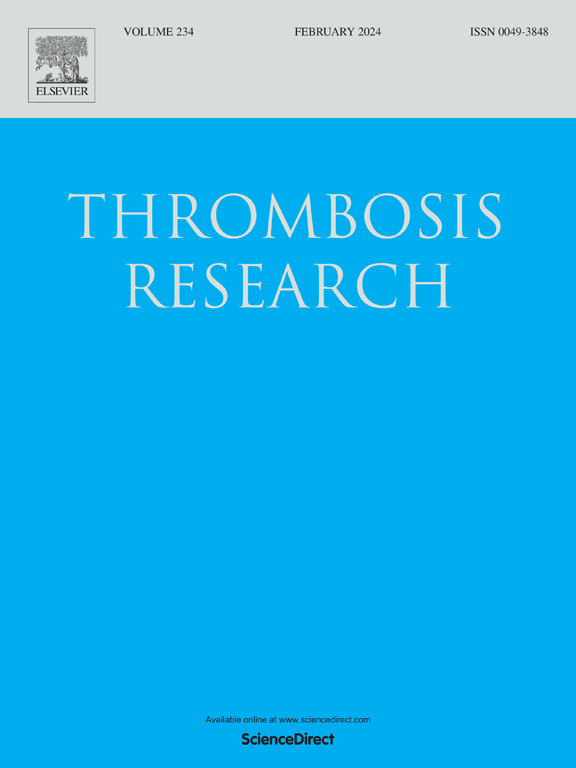Loss of von Willebrand factor large multimers in patients undergoing hemodialysis: A single-center, retrospective study
IF 3.7
3区 医学
Q1 HEMATOLOGY
引用次数: 0
Abstract
Introduction
Von Willebrand factor (VWF) is produced by vascular endothelial cells as large multimers and is cleaved by ADAMTS13 into an appropriate size in a shear stress-dependent manner. Excessive shear stress enhances VWF cleavage, leading to a hemorrhagic disease known as acquired von Willebrand syndrome. No clear reports on the prevalence of the loss of VWF large multimers in patients receiving hemodialysis are currently available. Therefore, this study investigated the prevalence of the loss of VWF large multimers in patients undergoing hemodialysis.
Methods
This single-center, retrospective study involved 90 patients undergoing hemodialysis and 32 healthy participants as controls. VWF antigen levels (VWF:Ag), VWF activity (VWF:RCo), and ADAMTS13 activity were measured. VWF multimer analysis was performed by modified western blotting with an agarose gel electrophoresis, followed by densitometric evaluation of band intensities to calculate the VWF large multimer index (VWF-LMI). A VWF-LMI <80 % was defined as the loss of VWF large multimers, and the prevalence of the loss of VWF large multimers was calculated.
Results
VWF:Ag and VWF:RCo levels in patients undergoing hemodialysis were significantly higher than those in healthy individuals (p < 0.01 both) and were negatively correlated with ADAMTS13 activity (p < 0.01, R = −0.353 and p < 0.01, R = −0.392, respectively). A VWF-LMI <80 % was present in 24 of 90 patients.
Conclusions
The loss of VWF large multimers was identified in 26.7 % of patients receiving hemodialysis. However, the prevalence of the loss of VWF multimers in these patients may be underestimated, as their relatively high VWF activity makes significant bleeding manifestations less likely.
血透患者血管性血友病因子大多聚体丧失:一项单中心回顾性研究
血管性血液病因子(VWF)是由血管内皮细胞产生的大型多聚体,由ADAMTS13以剪切应力依赖的方式切割成适当的大小。过度的剪切应力增强了VWF的切割,导致一种被称为获得性血管性血友病的出血性疾病。目前还没有关于接受血液透析的患者中VWF大多聚体丧失的发生率的明确报告。因此,本研究调查了血液透析患者中VWF大多聚体丢失的发生率。方法本研究为单中心回顾性研究,纳入90例血液透析患者和32例健康对照。测定VWF抗原水平(VWF:Ag)、VWF活性(VWF:RCo)和ADAMTS13活性。采用改良的琼脂糖凝胶电泳western blotting对VWF进行多聚体分析,然后用密度法评估条带强度,计算VWF大多聚体指数(VWF- lmi)。定义VWF- lmi <; 80%为VWF大型多定时器的损耗,并计算VWF大型多定时器损耗的发生率。结果血液透析患者血清VWF:Ag和VWF:RCo水平显著高于健康人群(p <;两者均为0.01),且与ADAMTS13活性呈负相关(p <;0.01, R = - 0.353, p <;0.01, R =−0.392)。90例患者中有24例出现VWF-LMI <; 80%。结论26.7%的血液透析患者存在VWF大多聚体缺失。然而,这些患者中VWF多聚体丧失的患病率可能被低估了,因为他们相对较高的VWF活性使显著出血表现的可能性降低。
本文章由计算机程序翻译,如有差异,请以英文原文为准。
求助全文
约1分钟内获得全文
求助全文
来源期刊

Thrombosis research
医学-外周血管病
CiteScore
14.60
自引率
4.00%
发文量
364
审稿时长
31 days
期刊介绍:
Thrombosis Research is an international journal dedicated to the swift dissemination of new information on thrombosis, hemostasis, and vascular biology, aimed at advancing both science and clinical care. The journal publishes peer-reviewed original research, reviews, editorials, opinions, and critiques, covering both basic and clinical studies. Priority is given to research that promises novel approaches in the diagnosis, therapy, prognosis, and prevention of thrombotic and hemorrhagic diseases.
 求助内容:
求助内容: 应助结果提醒方式:
应助结果提醒方式:


